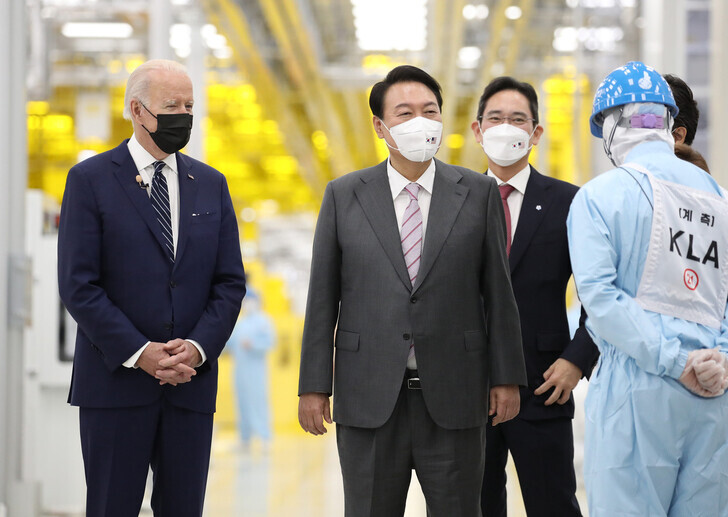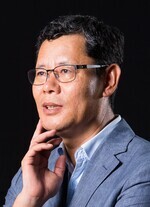hankyoreh
Links to other country sites 다른 나라 사이트 링크
[Guest essay] The semiconductor war calls for an innovation ecosystem


“’For want of a nail, the shoe was lost. For want of a shoe, the horse was lost.’ And it goes on and on until the kingdom was lost.”
This was what US President Joe Biden said in February 2021 when signing an executive order containing his strategy for revising semiconductor supply chains. Semiconductors may be mere components, but they determine convenience in the digital world that governs our day-to-day lives. They decide success or failure in the Fourth Industrial Revolution and the direction of technology supremacy.
For some time, the semiconductor has been a symbol of globalization. The US and Europe have been in charge of designing products with high added value, while South Korea and Taiwan have been tasked with manufacturing and assembly. China has provided upstream industry production along with a vast consumer market.
Those have been the guiding forces in the semiconductor industry: globalized production in which costs are lowered and efficiency raised through interdependence and comparative advantage.
But now the situation is changing. The era of globalization is over.
Even so, the accelerating digital revolution has led to an explosion in demand for semiconductors in areas such as artificial intelligence, 5G technology, the Internet of Things, and self-driving vehicles.
With supply failing to keep up with demand, the result has been a semiconductor crunch that has led to US and European automobile factories shutting down operations due to a lack of semiconductors. This is also the reason Biden made a Samsung semiconductor plant his first stop when he visited South Korea last month.
While demand has exploded, supply chains have been falling apart. The US imposed export controls that barred US companies from supplying semiconductors to Huawei, China’s leading information and communications company.
Bans on re-exportation have also blocked other companies from supplying semiconductors in cases where US components and technologies are included to a certain extent in their items. The US further closed off the future of Chinese semiconductors by preventing Dutch companies from supplying the lithography equipment that is so central to semiconductor technology competitiveness.
In its attempt to respond to the supply chain crisis while preserving its technology dominance, the US is seeking to establish a complete industry ecosystem domestically. It has increased the production capabilities of its own companies, while attracting semiconductor companies in South Korea and Taiwan to its soil.
What steps should Korea be taking amid the fog of post-globalization? We must take part in the US-led push to establish a new supply chain centering on allies — but the coordination of interests doesn’t happen on its own. Even as division of labor and cooperation increase within the bloc, there is inevitably going to be some competing for orders and grappling for technological dominance inside of it.
The US sanctions against Huawei weren’t actually the first. We should also recall what happened in the late 1980s, when the Japanese semiconductor industry collapsed due to US sanctions.
Post-globalization is starting now. As supply chains decouple, we need to strive to maintain a balance between clashing US and Chinese interests and between overinvestment and demand limits. In the words of Alvin Toffler, “If you don’t have a strategy, you’re part of someone else’s strategy.”
The role of the government is especially crucial. The neoliberal argument that we should reduce government intervention and leave things up to the market doesn’t work when it comes to the semiconductor industry. In addition to the US, we’re also seeing full-scale efforts by China, Taiwan and Japan to nurture their own semiconductor industries.
At its core, the strategy is about reducing supply chain unpredictability as much as possible. The supply chain crisis is going to continue for the foreseeable future, and Russia’s weaponization of key semiconductor materials just adds to it. South Korea’s rival Taiwan is working to lower its dependence on imports for materials, components, and equipment and to localize its supply chain domestically as much as possible.
South Korea has its own experience with successfully achieving domestic production of hydrogen fluoride and other materials, when the government, corporations, and SMEs banded together in response to Japan’s imposition of controls on exports of key semiconductor materials. Now it is time to institutionalize the gains from the crisis in the form of cooperation among companies in connection with materials, components, and equipment.
But for all the sloganeering that is going around, the practical situation is still dismal. How long have we been hearing about things like “industry/academia/research cooperation” and “shared growth between corporations and small businesses”? We always need to go see things on the ground to find our answers.
As the supply chain crisis has sent raw material prices skyrocketing, large corporations have been passing the burden of higher costs onto their subcontractors. Throughout South Korea, we hear the calls from SMEs demanding more realistic prices for their items.
Hopefully, the National Assembly will legislate a sliding system for prices. Obviously, this will bring its share of technical issues — but now is not a time for fixating on preserving profits for large corporations.
The area of semiconductors — logic chips in particular — is facing the typical issues with the subcontracting framework. The supply chain crisis has driven up production costs, but when the corporations don’t reflect those higher costs, this destroys the foundation for innovation by small businesses.
It’s time now for us to use our achievements in memory semiconductors, which rank among the world’s very best, as a basis for achieving progress in the true competitive arena of system conductors. Instead of a lot of talk about the need to “invest in people,” it’s time to practice sustainable industry/academia/research collaboration based on educational reforms.
We also need to be asking ourselves: How can we manage the long journey of post-globalization without an innovation ecosystem where large corporations and SMEs can grow together?
Please direct questions or comments to [english@hani.co.kr]

Editorial・opinion
![[Column] Season 2 of special prosecutor probe may be coming to Korea soon [Column] Season 2 of special prosecutor probe may be coming to Korea soon](https://flexible.img.hani.co.kr/flexible/normal/500/300/imgdb/original/2024/0426/3317141030699447.jpg) [Column] Season 2 of special prosecutor probe may be coming to Korea soon
[Column] Season 2 of special prosecutor probe may be coming to Korea soon![[Column] Park Geun-hye déjà vu in Yoon Suk-yeol [Column] Park Geun-hye déjà vu in Yoon Suk-yeol](https://flexible.img.hani.co.kr/flexible/normal/500/300/imgdb/original/2024/0424/651713945113788.jpg) [Column] Park Geun-hye déjà vu in Yoon Suk-yeol
[Column] Park Geun-hye déjà vu in Yoon Suk-yeol- [Editorial] New weight of N. Korea’s nuclear threats makes dialogue all the more urgent
- [Guest essay] The real reason Korea’s new right wants to dub Rhee a founding father
- [Column] ‘Choson’: Is it time we start referring to N. Korea in its own terms?
- [Editorial] Japan’s rewriting of history with Korea has gone too far
- [Column] The president’s questionable capacity for dialogue
- [Column] Are chaebol firms just pizza pies for families to divvy up as they please?
- [Column] Has Korea, too, crossed the Rubicon on China?
- [Correspondent’s column] In Japan’s alliance with US, echoes of its past alliances with UK
Most viewed articles
- 1AI is catching up with humans at a ‘shocking’ rate
- 2The dream K-drama boyfriend stealing hearts and screens in Japan
- 3‘We must say no’: Seoul defense chief on Korean, USFK involvement in hypothetical Taiwan crisis
- 4[Column] Season 2 of special prosecutor probe may be coming to Korea soon
- 5Is N. Korea threatening to test nukes in response to possible new US-led sanctions body?
- 6Is Japan about to snatch control of Line messenger from Korea’s Naver?
- 7[Column] Can we finally put to bed the theory that Sewol ferry crashed into a submarine?
- 8S. Korea “monitoring developments” after report of secret Chinese police station in Seoul
- 9Doubts remain over whether Yoon will get his money out of trip to Japan
- 10Up-and-coming Indonesian group StarBe spills what it learned during K-pop training in Seoul